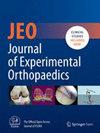Two-dimensional robot-assisted physeal-sparing medial patellofemoral ligament reconstruction can achieve favourable clinical outcomes for skeletally immature patients with recurrent patellar dislocation
Abstract
Purpose
The surgical treatment of recurrent patellar dislocation (PRD) in adolescents faces particular difficulties, since the integrity of open growth plates may be compromised by standard surgical methods used in adults. This study aimed to review a series of adolescents with RPD who underwent robot-assisted physeal-sparing medial patellofemoral ligament (MPFL) reconstruction, compare the clinical results with those of a non-robot-assisted group, and measure the vertical distance between Schöttle point and the physis intraoperatively.
Methods
This retrospective clinical analysis included 55 adolescents with RPD who had no significant bone deformities and underwent MPFL reconstruction using either a robot-assisted technique or a non-robot-assisted method between February 2019 to November 2023. Using a 2D intraopertive navigation system, the vertical distance between Schöttle point and the medial distal femoral physis was measured in the robot-assisted group. The operation duration, the number of fluoroscopies and guide needle punctures were recorded in both groups. The anterior and distal tilt angles of the bone tunnel, as well as the distance between Schöttle point and the femoral insertion of the bone tunnel (DST), were measured using postoperative CT imaging in both groups. In addition to CT, MRI, and radiographic evaluations, the International Knee Documentation Committee (IKDC), Lysholm and Kujala scores were used to assess the clinical outcomes.
Results
The mean patient age was 13.1 years (range, 11–16 years). At a mean of 35.5 ± 8.5 months postoperativel, all patients returned for evaluation. In the robot-assisted group, the mean distance from the Schöttle point to medial femoral physis was 6.97 ± 1.92 mm, with all Schöttle points positioned distal to the physis in every case. The IKDC, Lysholm and Kujala scores in the robot-assisted group were significantly higher than those in the non-robot-assisted group three months post-operatively (87.1 ± 6.1 vs. 82.9 ± 5.7, p = 0.011; 85.3 ± 5.7 vs. 81.1 ± 5.2, p = 0.007; 82.7 ± 6.0 vs. 77.5 ± 5.1, p = 0.001); however, at the last follow-up, there was no significant difference (p > 0.05). No patients experienced recurrent patellar instability or physeal invasion following surgery, and significantly improved functional scores and patellar tilt angles were noted at the final follow-up (p < 0.05). In the robot-assisted group, the number of fluoroscopy and guide needle punctures was significantly lower (3.7 ± 0.5 vs. 10.3 ± 1.8; 1.1 ± 0.3 vs. 5.7 ± 1.1, p < 0.001), with smaller anterior tilt angles (14.5 ± 1.7 vs. 16.6 ± 4.7, p = 0.044), larger distal tilt angles (13.8 ± 1.7 vs. 11.4 ± 1.5, p < 0.001) and shorter DST (2.00 ± 0.84 vs. 5.45 ± 1.74, p < 0.001) compared to the non-robot-assisted group.
Conclusion
An anterodistal oblique bone tunnel can be safely used for anatomical MPFL reconstruction in skeletally immature patients, yielding good short-term clinical outcomes. The robot-assisted method is more accurate than the freehand method, requiring fewer intraoperative fluoroscopies and enabling faster early recovery.
Level of Evidence
Level IV.

 求助内容:
求助内容: 应助结果提醒方式:
应助结果提醒方式:


